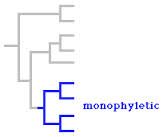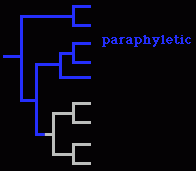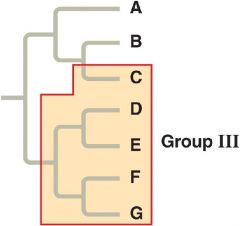![]()
![]()
![]()
Use LEFT and RIGHT arrow keys to navigate between flashcards;
Use UP and DOWN arrow keys to flip the card;
H to show hint;
A reads text to speech;
23 Cards in this Set
- Front
- Back
|
polytomy |
when you have 3+ branches connected on a tree. This is bad because you don't know that the common ancestors were and when speciation occured |
|
|
2 types homologies: |
structural, molecular |
|
|
molecular homologies: structural homologies: |
similarities from a common ancestor at a molecular level. You start with 2 species' DNA and work backwards. The more similar the DNA, the more likely it is they came from a common ancestor. Often a feature of a group such as mollusk's muscular foot. It can be modified such as a clam uses it for digging while a snail uses it for gliding, nautilus = tentacles to grasp but their common ancestor also had this foot. |
|
|
Shared ancestral versus shared derived character: Definitions: |
This is how you derive homology versus analogy for GROUPS you are comparing, although can be used for species too. Shared ancestral is any character found in an ancestral group that is also found in groups descended from that ancestor Shared derived is any character you find only in the group you're look at, but not seen in ancestor. It was derived independently. |
|
|
Degree of complexity and shared ancestral characters: |
the more similar 2 structures' DNA, and especially with complex structured, the more likely it is to have come from a common ancestor |
|
|
Depending on how far you go back, it depends on what's ancestral and what's derived. In group: Out group: |
The group(s) you're looking at
The group that has the closest common ancestor , but does not have the character you are looking at. This is the group you are comparing the in group to. |
|
|
If using out group, we are comparing to in group. If using basal, we are talking about the entire phylogenetic tree, usually a more complex one Vertebrae is a shared ancestral characteristic among vertebrates while hair is ancestral derived for mammals |
see other side
|
|
|
Example of analogous structures and homologous with same 2 species: This is why p-tree is a hypothesis and constantly changing as new info comes in |
bat and bird, wings are analogous while forearms in wings are homologous. Wings arose due to environment and not due to a common ancestor.
|
|
|
_______ can be used interchangeably with analogous structure in this course. Example of homoplasy: |
homoplasy Australian moles: same body shape, large front feet, small eyes, look at DNA: not closely related, but they have the same enivronment. They had a common ancestor at some point, but these characteristics DID NOT arise from them. Picture of only 5 similar genes = not closely related |
|
|
A shared derived characteristic is one which ______, while an analogous structure is for when you are ______. |
can define a group, comparing between |
|
|
______ is a method of naming groups, or _____. Any group of organisms that descended from a common ancestor can be in a group. Clades can also be nested within clades. |
Cladistics, clades |
|
|
3 types of phylogenetic trees: |
Monophyletic, paraphyletic, polyphyletic |
|
|
Monophyletic: |

includes ancestor and all groups descended from it. This is the ONLY ONE that has a clade and the ONLY ONE we want. |
|
|
Paraphyletic: |

includes and ancestor and SOME of the groups descended from it, but not all |
|
|
Polyphyletic: |

Includes an ancestor, the groups that descended from it, but it also includes species that descended from another ancestor. Often includes a polytomy |
|
|
Clade: |
An ancestor and everything that descended from it, they can be big or small and they can be nested in each other |
|
|
In most p-trees, branch length corresponds to _______. However, on some trees, branch length is _____________. For these, you must add _________. |
chronological/ geologic time proportional to the amount of evolutionary change, all of the horizontal lengths that separate them together. |
|
|
Steps/ Procedures to making a phylogenetic tree: Shared ancestral = clade |
1. systematists compare in-group species with other in-group species. 2. they compare in-group with out-group species 3. they try to differentiate between shared derived, shared ancestral. |
|
|
Principle of Maximum Parsimony: This is linked with: |
whatever is the simplest explanation is probably the correct one. Linked with occam's razor: the one with the least parts is probably correct. Investigate the simplest that is consistent with fact. The "simplest" would be decided based on morphology and DNA X --> XY -- XYZ OR XY --> XYZ --> X? The first has fewer changes |
|
|
Principle of Maximum Likelihood: |
The one that is statistically most likely and most constant is usually true. For instance, it is more likely that fungi, humans and tulips all changed equally instead of one changing a lot. This principle does not always hold true |
|
|
Example of how parsimony has been used: |
to infer characteristics of dinosaurs from those of birds and crocodiles. Birds = in-group, crocs = outgroup. Whatever the two share was likely shared by common ancestor of crocs, dinos and birds. 4 chamber heart (most reptiles have 3, but birds and crocs have 4), singing, brooding (also supported by dino fossils), make nests |
|
|
Different genes evolve at different rates, so p-trees are constantly being fine-tuned. The tree of life is more like a web. One complication is that genes can go from one species to another. _______ are used as a yardstick. |
molecular clocks |
|
|
Explain how molecular clocks are used: |
1. Take general mutation rates 2. Correlate against geologic time scale 3. Then use this general info to compare when species came about. This is not exact |

